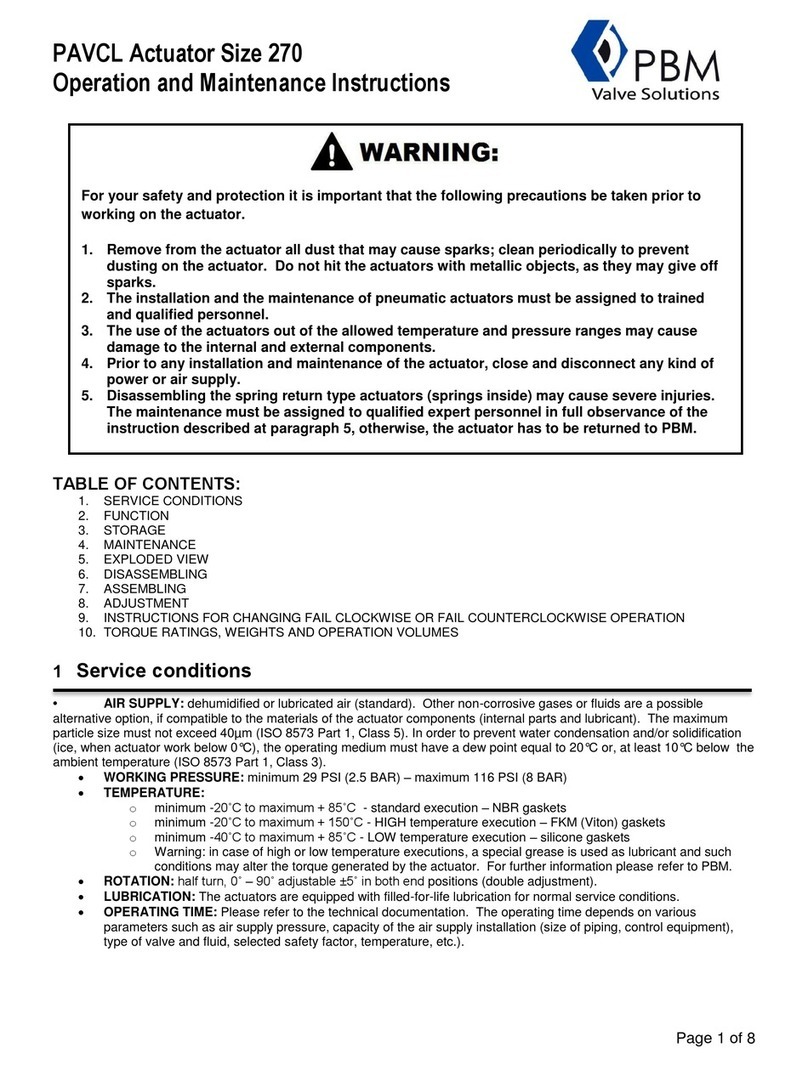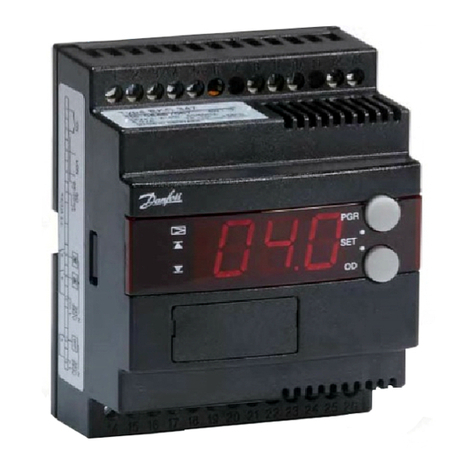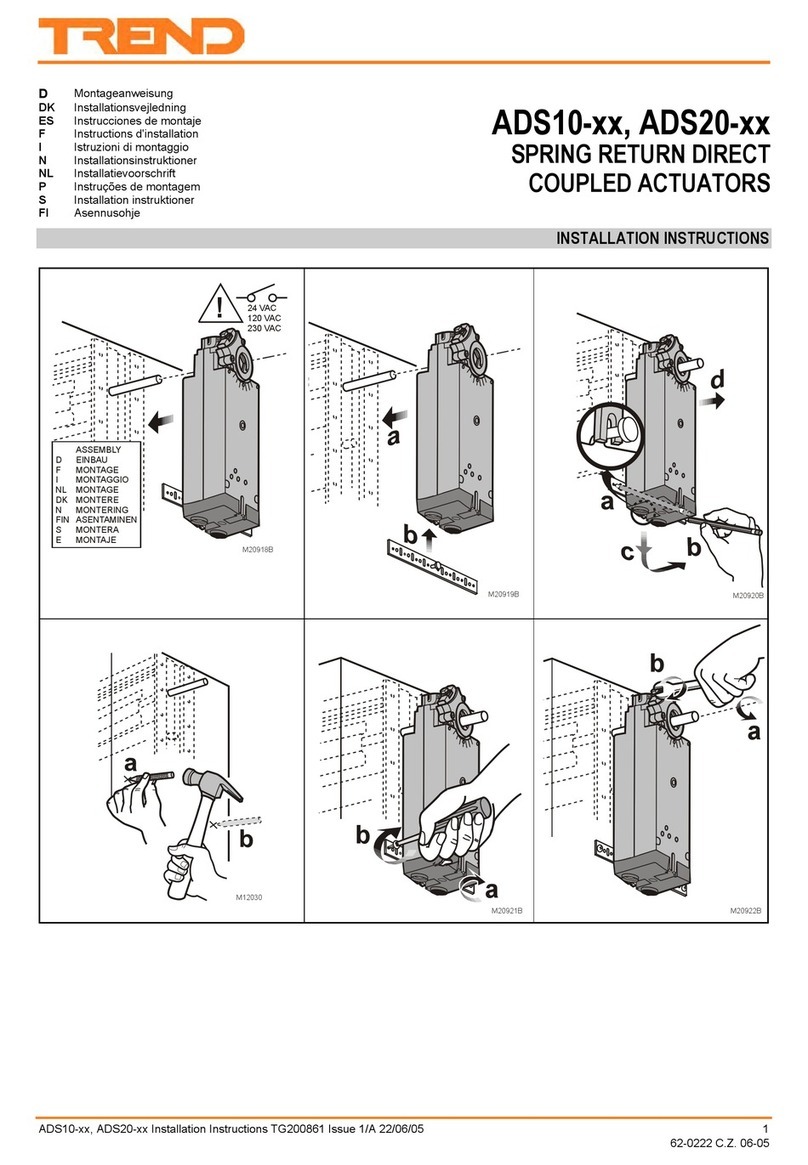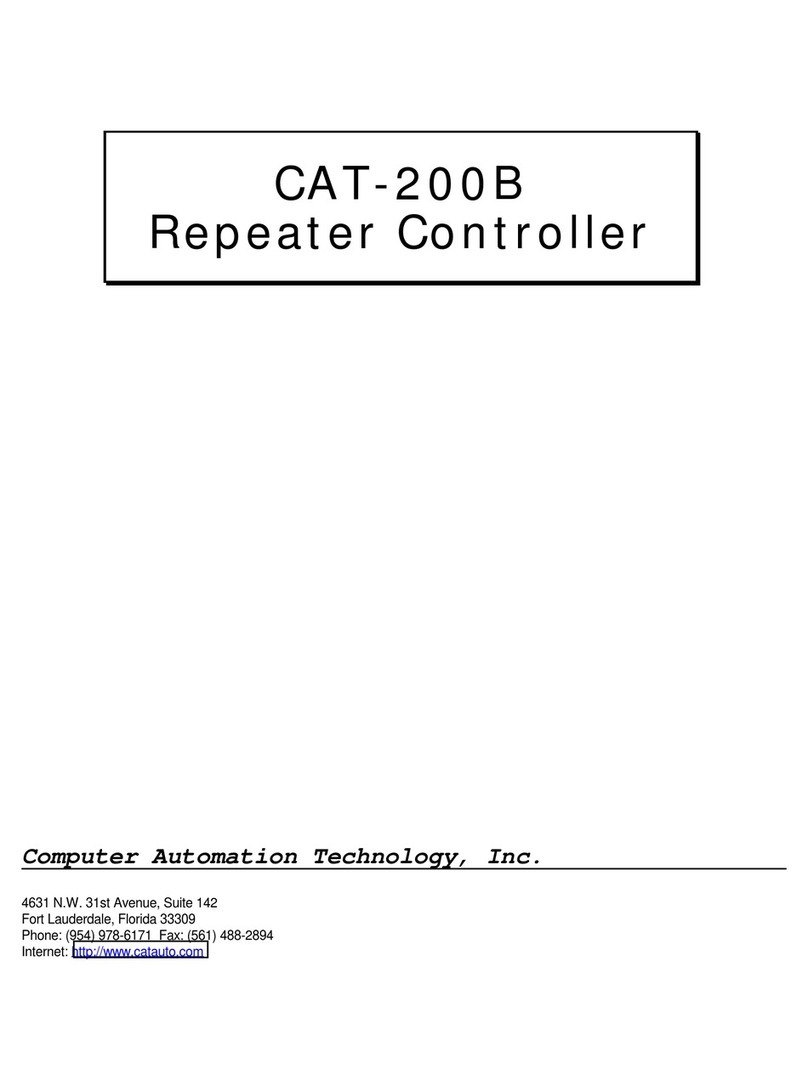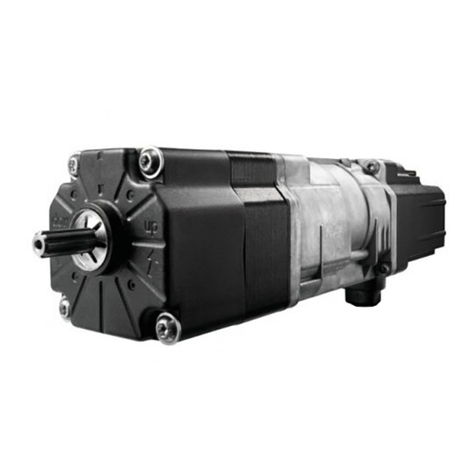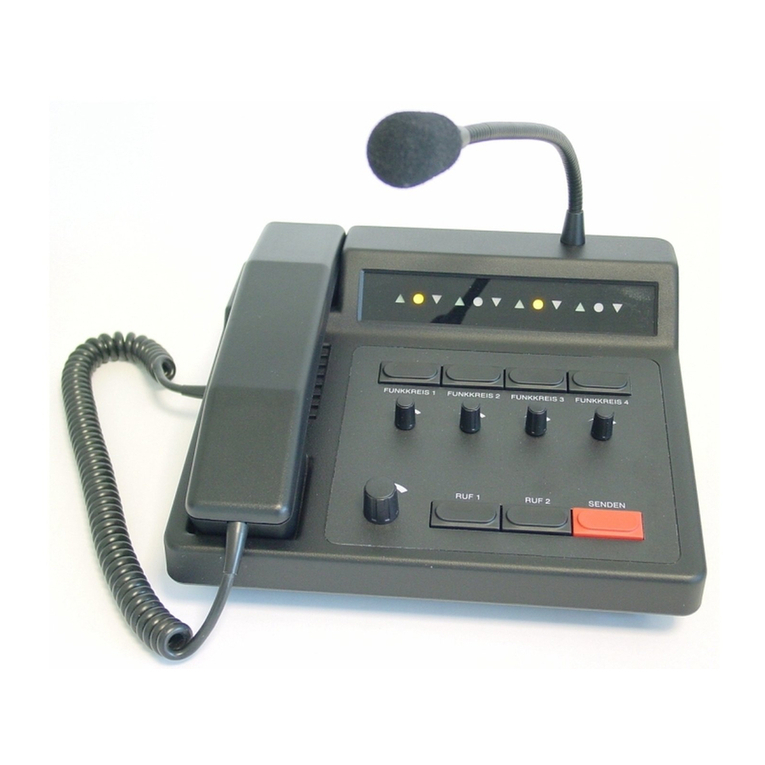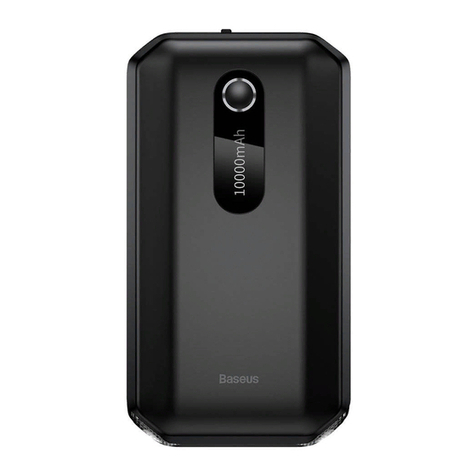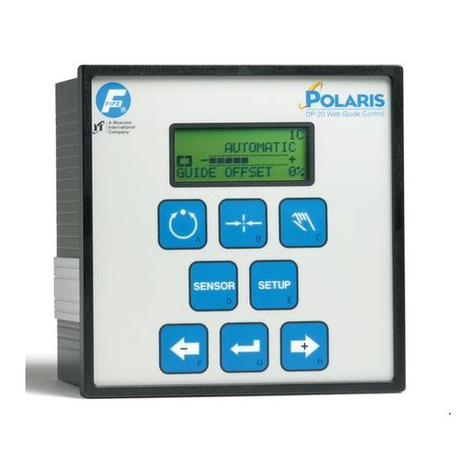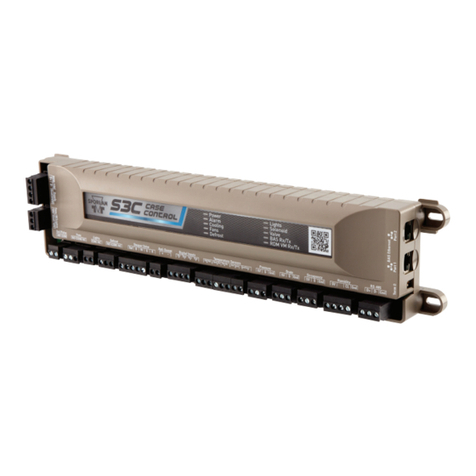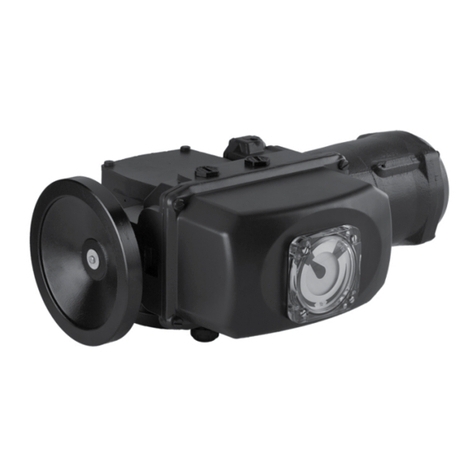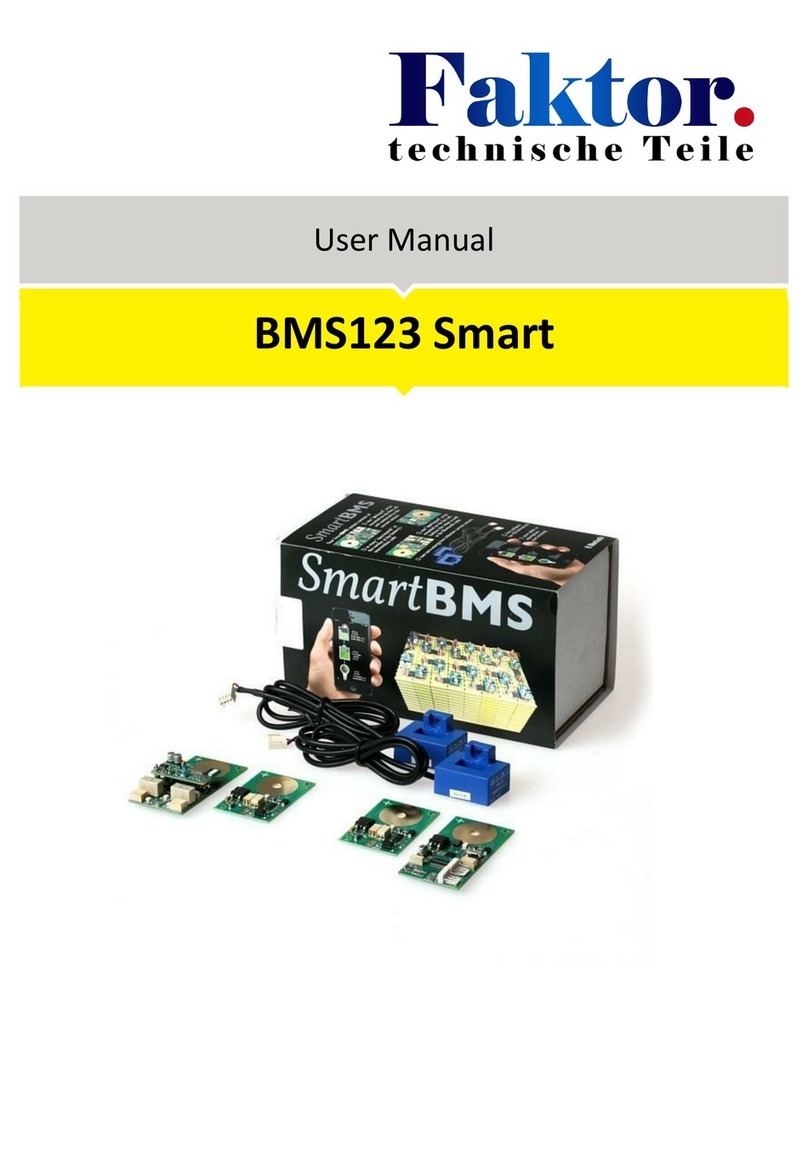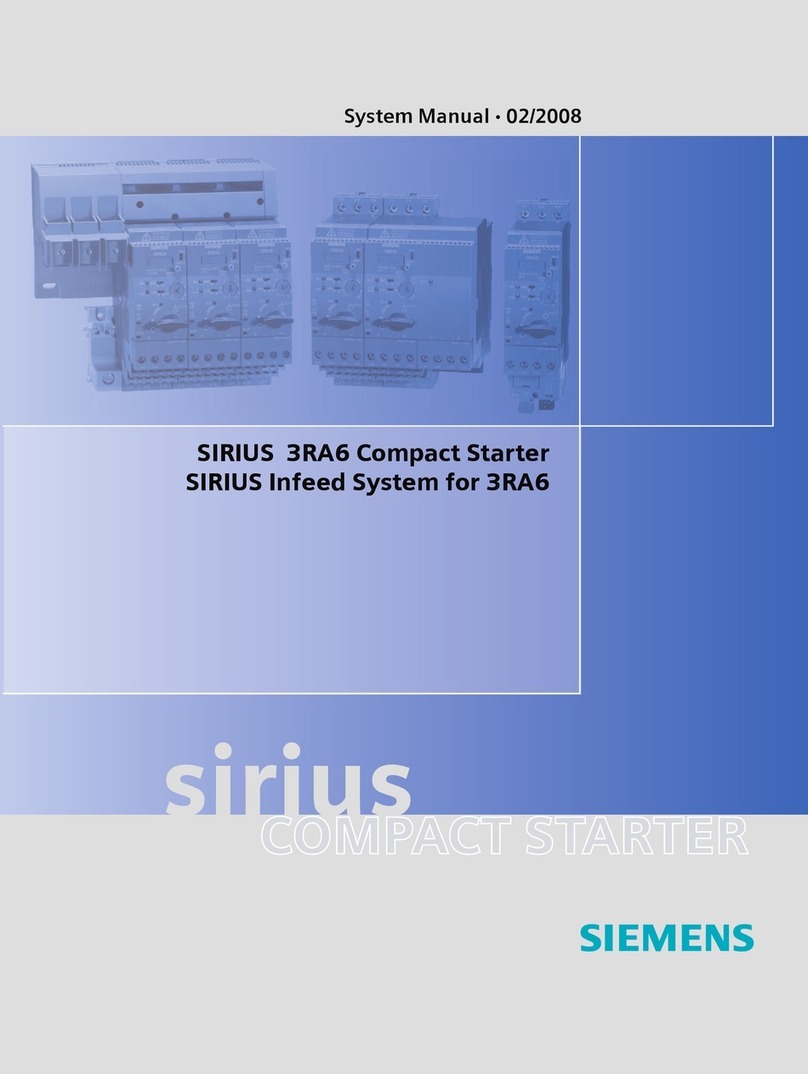PBM PAVBL Series Troubleshooting guide

Page 1 of 8
PAVBL Actuator Sizes 0052 thru 0270
Operation and Maintenance Instructions
TABLE OF CONTENTS:
1. SERVICE CONDITIONS
2. FUNCTION
3. STORAGE
4. MAINTENANCE
5. EXPLODED VIEW
6. DISASSEMBLING
7. ASSEMBLING
8. ADJUSTMENT
9. INSTRUCTIONS FOR CHANGING FAIL CLOCKWISE OR FAIL COUNTERCLOCKWISE OPERATION
10. TORQUE RATINGS, WEIGHTS AND OPERATION VOLUMES
1 Service conditions
• AIR SUPPLY: dehumidified or lubricated air (standard). Other non-corrosive gases or fluids are a possible
alternative option, if compatible to the materials of the actuator components (internal parts and lubricant). The maximum
particle size must not exceed 40µm (ISO 8573 Part 1, Class 5). In order to prevent water condensation and/or solidification
(ice, when actuator work below 0°C), the operating medium must have a dew point equal to 20°C or, at least 10°C below the
ambient temperature (ISO 8573 Part 1, Class 3).
WORKING PRESSURE: minimum 29 PSI (2.5 BAR) –maximum 116 PSI (8 BAR)
TEMPERATURE:
ominimum -20˚C to maximum + 85˚C - standard execution –NBR gaskets
ominimum -20˚C to maximum + 150˚C - HIGH temperature execution –FKM (Viton) gaskets
ominimum -40˚C to maximum + 85˚C - LOW temperature execution –silicone gaskets
oWarning: in case of high or low temperature executions, a special grease is used as lubricant and such
conditions may alter the torque generated by the actuator. For further information please refer to PBM.
ROTATION: half turn, 0˚ – 90˚ adjustable ±5˚ in both end positions (double adjustment).
LUBRICATION: The actuators are equipped with filled-for-life lubrication for normal service conditions.
OPERATING TIME: Please refer to the technical documentation. The operating time depends on various
parameters such as air supply pressure, capacity of the air supply installation (size of piping, control equipment),
type of valve and fluid, selected safety factor, temperature, etc.).
For your safety and protection it is important that the following precautions be taken prior to
working on the actuator.
1. Remove from the actuator all dust that may cause sparks; clean periodically to prevent
dusting on the actuator. Do not hit the actuators with metallic objects, as they may give off
sparks.
2. The installation and the maintenance of pneumatic actuators must be assigned to trained
and qualified personnel.
3. The use of the actuators out of the allowed temperature and pressure ranges may cause
damage to the internal and external components.
4. Prior to any installation and maintenance of the actuator, close and disconnect any kind of
power or air supply.
5. Disassembling the spring return type actuators (springs inside) may cause severe injuries.
The maintenance must be assigned to qualified expert personnel in full observance of the
instruction described at paragraph 5, otherwise, the actuator has to be returned to PBM.

Page 2 of 8
2 Function
The air pressure acts on the surface of the pistons (12) causing their alternate movement, which is converted into rotation
(standard 90°) of the pinion (2) as a result, the pneumatic actuators can be used for remote operation of valves.
2.1 Double Acting

Page 3 of 8
5 Exploded View
* Part subject to wear
** Reinforced series DIN471 –UNI 7436
*** Mod. 160-200
% Mod. 270 Only
Springs for Mod. 270 Number of springs each side for spring return
60 PSI is 4/5 (Spring Set 05) 80 PSI is 6/6 (Spring Set 8)
POS.
Description
Material
DA
SR
1
Body
Extruded Aluminum
1
1
2
Anti-blowout pinion
Steel
1
1
*3
O-ring
NBR
1
1
*4
Spacer Ring
POM
1
1
*5
O-ring
NBR
1
1
6
Spacer
POM
1
1
7
Cam
Stainless Steel
1
1
8
Position Indicator
Nylon
2
2
9
Washer
Stainless Steel
1
1
**10
Snap Ring
Steel
1
1
11
Piston
Die Cast Aluminum
2
2
*12
O-ring
NBR
2
2
*13
Anti-friction Ring
PTFE 15% Graphite
2
2
*14
Thrust Block
POM
2
2
15
Stop Bolt Retaining Nut
Stainless Steel
2
2
16
Stop Bolt
Stainless Steel
2
2
17
External Spring
Steel
0
See
Table
***
Central Spring
Steel
0
18
Internal Spring
Steel
0
19
Left End Cap
Die Cast Aluminum
1
1
20
Right End Cap
Die Cast Aluminum
1
1
21
End Cap Seats
NBR
2
2
22
End Cap Fixing Screw
Stainless Steel
8
8
%23
Spring
Steel
0
Below
%24
Anti-friction Ring
PTFE 15% Graphite
1
1
%25
Washer
Stainless Steel
1
1
Valid from Mod. 0052 to 0140
Spring Setting
SET
External
Spring
Internal
Spring
01
1
1
02
2
03
1
2
04
2
1
05
2
2
Valid from Mod. 0160 to 0200
Spring Setting
SET
External
Spring
Central
Spring
Internal
Spring
01
2
02
2
03
1
2
04
2
2
05
2
2
06
2
2
2

Page 4 of 8
6 Disassembling
6.1 Disassembling mod. 0052 to mod. 0270
CAUTION : It is recommended to use suitable safety equipment during the handling for maintenance because of heavy
and/or bulky parts.
1. Disconnect pneumatic and electric supplies from the actuator;
2. After having disconnected their power supply, remove carefully any accessory attached to the actuator, preventing any
damage during the handling;
3. Detach the actuator from the valve taking careful note of all references that may be helpful for the attachment after
maintenance.
4. Place the actuator on a support with a square of the same size of the pinion ( 2 ) so as to easily execute the below listed
operation (see Fig. 1):
5. Before disassembling the actuator check from the label on the body whether it is a double acting (DA) or spring return
(SR ) type;
6. For DOUBLE ACTING ACTUATOR: Unscrew in crossed sequence the screws ( 25 ) for fastening the end caps ( 21-22 )
see Fig. 2
7. For SPRING RETURN ACTUATOR: Unscrew GRADUALLY in crossed sequence the screws (25) for fastening the end
caps ( 21-22 ), Fig. 2; Note: the screws are long enough to hold the springs even if extended; Loosen nuts ( 16 ) and
unscrew completely screws ( 17 ) see Fig. 3 ;
8. Rotate the cylinder ( 1 ) in CLOCKWISE direction (top view) holding the pinion ( 2 ) so as to release the rack of the
pistons ( 12 ) from the pinion ( 2 ) and to push the pistons towards to the cylinder ends. Now both pistons ( 12 ) can be
removed see Fig. 4.
NOTE: Do not use compressed air to remove the pistons ( 12 ) from the cylinder ( 1 )
9. Remove the snap ring ( 11 ) from the pinion ( 2 ), the washer ( 10 ), the spacer ( 9 ) and the O-ring ( 6 ) see Fig. 5 ;
10. Extract the pinion ( 2 ) from the cylinder ( 1 ) by pushing it down, with special caution for all seating’s, see Fig. 5
(if necessary use a rubber hammer);
11. Tilt the cylinder (1) and let the cam (7) slide out, see Fig. 5.

Page 5 of 8
7 Assembling
7.1 Assembling mod. 0052 to mod. 0270
CAUTION: It is recommended to use suitable safety equipment during the handling for maintenance because of heavy
and/or bulky parts.
1. Before assembling clean all components preferably with degreaser.
2. Place the pinion ( 2 ) on a support with a square of the same size of the female attachment. Make sure that the pinion is
provided with lower O-ring ( 3 ), spacer ( 4 ) and upper O-ring ( 5 ). Lubricate the O-rings (see arrows fig. 13). The
recommended lubricating grease is “KLUBER” TRIBO STAR 1EP“
3. Screw down one adjustment screw ( 17 ) with nut ( 16 ) in the right adjustment hole of the cylinder ( 1 ) and let the cam (7)
with ring ( 8 ) slide down on the guiding rail on the cylinder ( 1 ) (see detail. A Fig.14) until it stops against the screw;
4. Lay the cylinder ( 1 ) down on the pinion ( 2 ) holding it with the NAMUR surface rotated by approx. 50° to the upper slot
of the pinion, see fig. 15 ;
5. Fit on the pinion ( 2 ) the O-ring ( 6 ), the spacer ( 9 ), the washer ( 10 ), the snap ring ( 11 ), see Fig. 16 ;
6. Grease the internal chamber of the cylinder ( 1 ) and both pistons ( 12 ) provided with O-ring ( 13 ) antifriction ring ( 14 )
and thrust block ( 15 ) The recommended lubricating grease is “KLUBER” TRIBO STAR 1EP“.
7. For the standard execution (clockwise rotation opens) press the pistons ( 12 ) into the cylinder ( 1 ) while turning the
cylinder ( 1 ) in counterclockwise direction ( top view) until the pistons come into contact, see fig. 17 ;
8. Screw down the second adjustment screw ( 17 ) with nut ( 16 ) in the cylinder (1) and adjust the travel stop, paragraph 8;
9. For DOUBLE ACTING ACTUATOR: Mount the end cap ( 21-22 ) with O-ring ( 24 ) and gasket ( 23 ) on the cylinder and
screw down in crossed sequence the screws ( 25 ), see fig. 18. Repeat the operation on the opposite side.
For SPRING RETURN ACTUATOR: Introduce the spring set ( 18-19-20 ) into the cylinder ( 1 ) and center them on the piston
( 12 ), then mount the caps ( 21-22 ) with O-ring ( 24 ) and gaskets ( 23 ) centered on the springs ( 18-19-20 ). Note: the
pistons have to be in CLOSED position. Screw partially down the screws ( 25 ) in crossed sequence compressing the springs
uniformly until the cap is completely closed, see fig. 18. Repeat the operation on the opposite side;
10. Execute some test cycles to check the correct functioning of the actuator before installing it.

Page 6 of 8
8 Adjustment
By means of the left screw the 90° end position ( open ) can be adjusted, see Fig. 27, of the right screw the 0°end position
(closed), see Fig. 28.
NOTE : During the adjustment the pinion must not be blocked on the support.
8.1 Adjustment procedure, actuator in counter clockwise position
• Put the actuator in clockwise position;
• Adjust by means of the left adjustment screw ( L );
• Put the actuator in counter clockwise position and check the adjustment
• Repeat until the desired adjustment is achieved;
• Hold the screw in the correct position and tighten the nut.
8.2 Adjustment procedure, actuator in clockwise position
• Put the actuator in counter clockwise position (supply compressed air for mod SR);
• Adjust by means of the right adjustment screw ( R);;
• Put the actuator in clockwise position and check the adjustment (interrupt the air supply for mod.SR);
• Repeat until the desired adjustment is achieved;
• Hold the screw in the correct position and tighten the nut.

Page 7 of 8
9. Instructions for Changing Fail Clockwise or Fail Counterclockwise
Operation of Pneumatic Actuators
1. Instruction
For normal Fail Close operation, the left side piston/rack
is positioned at the back of the housing when facing the air
nozzles and the right side piston/rack is positioned on the
near side of the housing. This will cause clockwise rotation
of the pinion when looking down on the actuator when the
springs cause the pinion to rotate and counter-clockwise
rotation of the actuator when air causes the pinion to
rotate. If it is desired to rotate the pinion counter-clockwise
when the springs cause the pinion to rotate, the locations
of the two pistons/racks should be reversed.
This is Normal Fail Close Operation –Note the location of the Piston Racks
Right Piston Rack is in Front –Just Behind Air Supply Parts
This is Normal Fail Close Operation –Note the location of the Piston Racks
Right Piston Rack is in Front –Just Behind Air Supply Parts
For your safety and protection it is important
that the following precautions be taken prior to
working on the actuator.
1. Remove from the actuator all dust that may
cause sparks; clean periodically to prevent
dust on the actuator.
2. The installation and the maintenance of
pneumatic actuators must be assigned to
trained and qualified personnel.
3. Prior to any installation and maintenance of
the actuator, close and disconnect any kind
of power or air supply.
4. Disassembling the spring return type
actuators (springs inside) may cause severe
injuries.

Page 8 of 8
10 Torque Ratings, Weights and Operation Volumes
SPRING RETURN ACTUATORS
Actuator Model
Spring Set
Spring Torque Output
(in-lbs.)
Air Pressure at Actuator (psig)
60
80
Torque Output from Pressure (in-lbs)
Start
End
Start
End
Start
End
PAVBL253S - -0052
3
66
38
80
47
N/A
N/A
PAVBL453S - -0052
5
88
60
N/A
N/A
101
55
PAVBL253S - -0063
3
128
71
149
79
N/A
N/A
PAVBL453S - -0063
5
196
111
N/A
N/A
193
95
PAVBL253S - -0075
3
234
125
275
137
N/A
N/A
PAVBL453S - -0075
5
358
193
N/A
N/A
354
157
PAVBL253S - -0085
3
307
183
387
211
N/A
N/A
PAVBL453S - -0085
5
456
273
N/A
N/A
503
257
PAVBL253S - -0100
3
495
279
628
329
N/A
N/A
PAVBL453S - -0100
5
733
417
N/A
N/A
802
378
PAVBL253S - -0115
3
786
442
1,044
541
N/A
N/A
PAVBL453S - -0115
5
1,176
657
N/A
N/A
1,352
637
PAVBL253S - -0125
3
969
611
1,351
640
N/A
N/A
PAVBL453S - -0125
5
1,412
900
N/A
N/A
1,762
789
PAVBL253S - -0140
3
1,617
853
1,910
856
N/A
N/A
PAVBL453S - -0140
5
2,251
1,200
N/A
N/A
2,481
1,017
PAVBL253S - -0160
4
2,443
1,522
2,447
1,350
N/A
N/A
PAVBL453S - -0160
5
2,860
1,917
N/A
N/A
3,452
2,240
PAVBL253S - -0200
4
4,040
2,686
4,788
3,080
N/A
N/A
PAVBL453S - -0200
6
5,900
4,009
N/A
N/A
5,893
3,539
PAVBL253S - -0270
5
10,788
6,915
11,495
6,884
N/A
N/A
PAVBL453S - -0270
8
14,387
9,230
N/A
N/A
15,360
9,220
WEIGHTS AND VOLUMES DOUBLE ACTING ACTUATORS
Actuator Model
Rotate
CCW
Rotate
CW
PAVC
series
Actuator Model
Air pressure at actuator (psig)
Volume
(cu.in.)
Volume
(cu.in.)
Approx.
weight
(lbs.)
60 psig
80 psig
Constant Torque Output
PAVBL453D - - 0052
6.1
7.9
2.3
PAVBL453D - - 0052
133
179
PAVBL453S - - 0052
6.1
6.7
3.0
PAVBL453D - - 0063
238
321
PAVBL453D - - 0063
12
14
4.4
PAVBL453D - - 0075
435
586
PAVBL453S - - 0063
12
11.6
5.3
PAVBL453D - - 0085
629
851
PAVBL453D - - 0075
22
27
7.7
PAVBL453D - - 0100
991
1,336
PAVBL453S - - 0075
22
22
9.1
PAVBL453D - - 0115
1,640
2,210
PAVBL453D - - 0085
31
39
10.4
PAVBL453D - - 0125
2,157
2,906
PAVBL453S - - 0085
31
32
12.9
PAVBL453D - - 0140
3,013
4,018
PAVBL453D - - 0100
48
61
14.7
PAVBL453D - - 0160
4,394
5,859
PAVBL453S - - 0100
48
49
18.8
PAVBL453D - -0200
8,239
10,981
PAVBL453D - - 0115
79
104
23.7
PAVBL453D - - 0270
19,097
25,469
PAVBL453S - - 0115
79
84
30.7
PAVBL453D - - 0125
99
135
28.9
PAVBL453S - - 0125
99
109
37.7
PAVBL453D - - 0140
138
193
43.7
PAVBL453S - - 0140
138
146
57.6
PAVBL453D - - 0160
220
290
58.3
PAVBL453S - - 0160
220
215
79
PAVBL453D - - 0200
350
600
99.1
PAVBL453S - - 0200
348
463
147
PAVBL453D - - 0270
915
1,086
222
PAVBL453S - - 0270
915
946
269
PBM, Inc., 1070 Sandy Hill Road, Irwin, PA 15642
Phone: (724) 863-0550 or (800) 967-4PBM
Fax: (724) 864-9255
© Copyright 2018 PBM, Inc. IOM-ACTUATOR-B R0 10/18 Printed in USA
This manual suits for next models
3
Table of contents
Other PBM Controllers manuals
